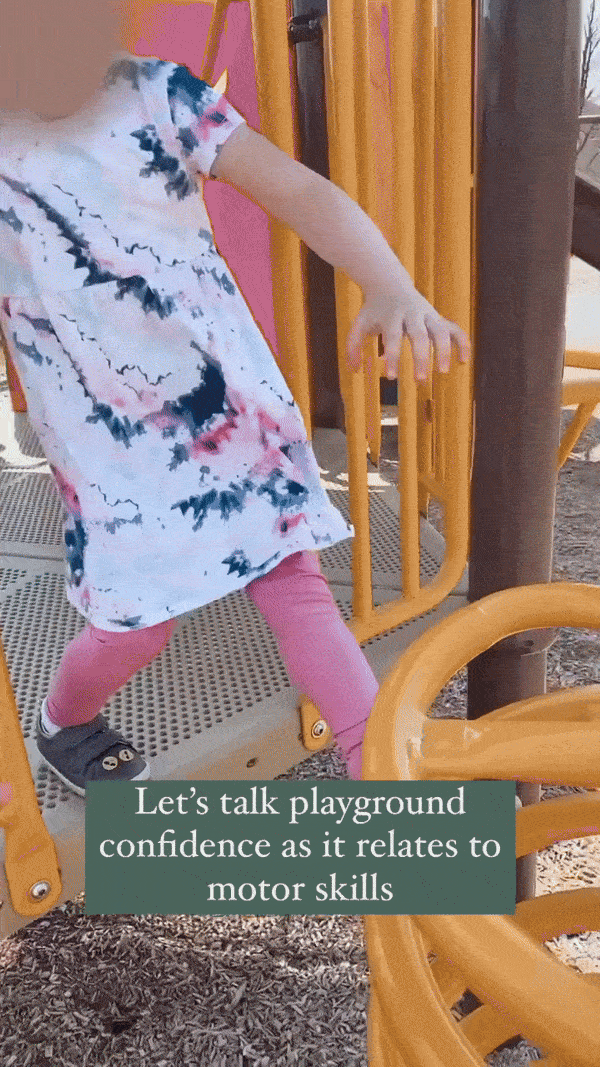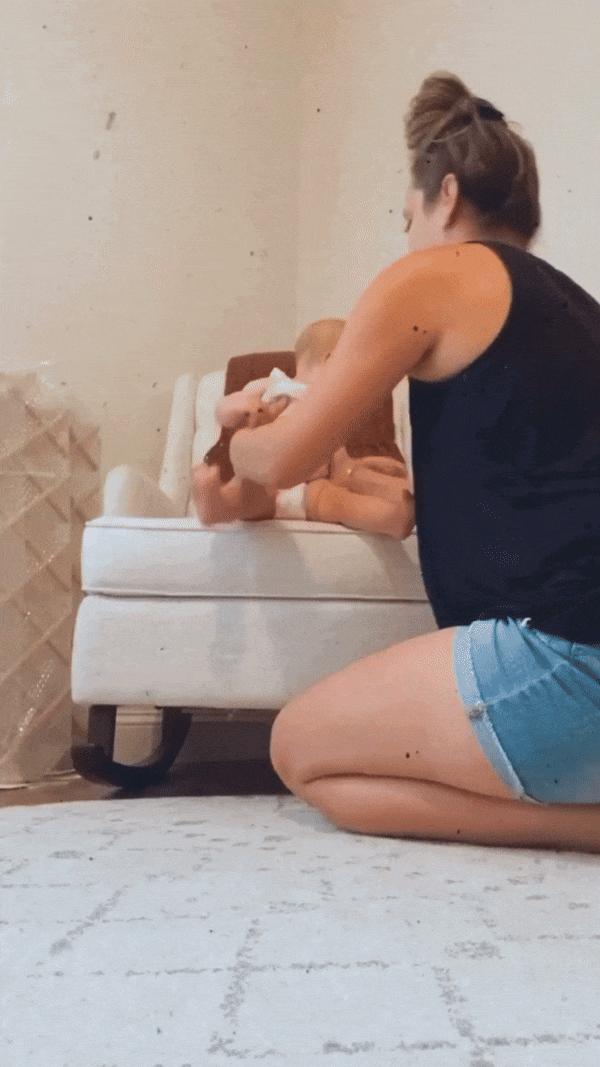Baby Safety: Safety Tips For Parents While Still Encouraging Development
THIS POST MAY CONTAIN AFFILIATE LINKS, WHICH MEANS I MAY EARN A SMALL COMMISSION AT NO EXTRA COST TO YOU, IF YOU MAKE A PURCHASE THROUGH ONE OF MY LINKS. I ONLY SHARE PRODUCTS I TRULY LOVE AND USE FOR MYSELF OR WITH MY OWN KIDS AND PATIENTS. THANK YOU FOR SUPPORTING THIS SPACE!
How can I keep my baby safe while also fostering independence?!
ANSWER: As a Pediatric Physical Therapist and mom of 3 myself, I know firsthand how overwhelming it can feel to try to do our best to keep our little one’s safe while simultaneously letting them explore, make mistakes, take risks, and gain independence.
With September being Baby Safety Month, I wanted to share some tips & tricks I’ve learned both as a pediatric physical therapist and mom, so you can feel confident navigating your little one’s milestones & exploration confidently and safely!
Keep reading for my advice on mastering milestones, including some of my most requested tips for navigating common hurdles like Furniture safety, playground safety & navigating stairs safety!
Motor Skills & Safety
When it comes to a child learning a new motor skill, I like to consider four main components:
Motivation & Personality - there has to be a desire to explore their environment. Consider a child on a playground. Some children go for for it no holds barred with very little apprehension or fear, while another may quietly observe the other kids, maybe attempt it when there are less eyes on them, or may ask for more support than they may physically need. Wherever you little one falls, that’s absolutely okay - and tuning into the things they may need to help them feel safe, boost their motivation & ultimately encourage their exploration can make a world of difference!
Confidence - as a child attempts a skill, they gain feedback both internally and externally, which helps them problem solve, create a new motor plan if needed and ultimately master the skill with less and less support as their confidence in their abilities increases!
Strength & Coordination - every single skill your child navigates requires the development of both strength & coordination, which then allow them to attempt the skill, change their approach and motor plan as needed to be successful, and ultimately master both the ministones (the little skills that lead to the big skill) AND the big milestone we are so excited to see!
Repetition of the task - aka, they need the opportunity to practice - and ideally, these opportunities happen often!
So ultimately, how can we foster motor skill development for our little ones? Opportunity and support! I start by giving support & intentional opportunities, aiming for them to do as much of the task as they can safely & confidently before I intervene. Here’s an example of exactly this, playground edition:
In the clip, you can see I gently have my hand on her back as I am coaching her all along “one foot down, move your hand, other foot down, move your hand” in a sing song to help her figure out the motor plan for success. If she needed more help, I would physically and verbally provide that, and back off as the ability & confidence to execute the task improve. After the first time with help and that song, she then did it on her own while singing that song to herself. Repeat x500 🤪 and she had it nailed down!
It’s the same idea with earlier motor skills- like rolling, sitting, crawling, and walking. Some little ones just go for it, some need some intentional environmental set up, some may benefit from purposeful play, some need a varying amount of assistance, and some may figure out an original way to success - and it’s all absolutely okay!
My biggest encouragement is to let them explore! Give them the opportunity, meet them where they’re at and give their individual needs attention - you know your baby best, and you’ve both got this!
Now…what about playground safety??! Let’s talk about it…..
Playground Safety
I will never forget how anxiety inducing playgrounds used to be for me (and still can be!), especially when my kids were younger and at VERY different motor ability levels - and the intrusive thoughts, don’t even get me started 😵💫
What if a bigger kid pushed them?
What if they got hurt on the slide? Or stuck in a spot I couldn’t get to them?
What if they slipped and fell from the top between those openings (which also like WHYYYYY are they there and always at the tippy tippy top?!)
And don’t even get me going on how inaccessible most playgrounds are 😡
Having 3 little ones fairly close in age (20 months between oldest to mid, 20 months mid to youngest) meant for a long time, they were at VERY different ability levels. One was running while one was toddling along, while the other was just starting to crawl…it was….real 🙃. BUT as a pediatric physical therapist, I knew the benefits of risky play, climbing & exploration - so we soldiered on. And after 6 years of navigating it, I figured I’d kick off this week with some of the tips I learned that really helped me find a happy medium between my worried mom brain & my PT brain. Plus therapy….therapy helped a lot 😂
And while I TOTALLY get the struggle - reminding myself that risky play truly is SO beneficial for our little ones helped me push through too- risky play is huge for development cognitively, emotionally, learning to assess risks, motor plan novel situations, strengthening, coordination, resilience, problem solving, social skill development, confidence, creativity & so much more!
So- here’s my top tips for navigating playgrounds with children at different ability levels - and I’d love to hear if you have any tips too!
-Aim for fenced in playgrounds. Honestly, can we just make fenced in playgrounds standard?!
-Search for playgrounds near you that are accessible AND inclusive - it’s amazing to support inclusion in our communities & they’ll likely have flooring that is better for crawling little ones as compared to mulch, which is a pain, totally inaccessible & also way too tempting to put in their mouths!
-Stick to familiar playgrounds that you know your biggest kiddo can navigate fairly safely
-Aim for times of day when they’ll likely be less busy with bigger kids - if your kids aren’t school aged, early morning is usually perfect!
-Know that it gets better - before you know it, they’ll feel more confident, you’ll feel more confident, and the nerves that come with navigating playgrounds will be less & less. You got this!
An Important Note on Slides:
Our children getting seriously injured obviously isn’t a topic anyone loves to think about, but when it comes to slides, the risk is VERY real & slide safety is something I firmly believe every parent and caregiver should be aware of, so let’s talk about it.
Did you know….
Research shows that the younger a child is, the more likely they’ll be to go down a slide on an adult’s lap, which means the higher the risk of a tibia (lower leg) fracture 😳.
Again- the younger a child is, the more at risk they are to have their leg broken when going down a slide on an adult’s lap.
That's because when on an adult’s lap, a child’s leg can easily get trapped or slip between/behind your legs, and the weight of the adult sliding down causes their lower leg to break...
*Don’t google it. Really. just trust me on this one.*
When it comes to slide safety, my advice is:
Let them go down solo, on age appropriate slides, with you ready to catch them.
If you absolutely have to have them on your lap for safety, I personally secure their legs like in the picture below, firmly grabbing both legs/ankles so they are unable to move them into a potentially dangerous position.
What about furniture & stair safety?!
Probably one of the biggest questions I get is how to teach little ones to SAFELY navigate furniture & stairs, so let’s talk about it…..
Furniture & Stairs
When it comes to furniture safety & stairs, my BIGGEST advice is to START EARLY!
As soon as baby becomes mobile, honestly even when they are just starting to sit (often around 6 months of age), I start encouraging them to flip to their belly & slide feet first off of furniture.
Then, take *every single* opportunity you can to practice it - every single time they get off the couch or a bed, flip them to their belly and encourage them to slide down feet first. Same goes for the stairs if you have them in your home - more on that below! When moving them through the motion of flipping to their belly and sliding feet first, I also recommend picking ONE phrase and sticking with it to prompt them. We say “flip to your belly, feet first, down down down!”, but whatever works for your family is perfect!
With furniture and stair safety, it absolutely takes time for them to nail it down (especially if they are on the younger side when you start), but don’t give up! I promise, they WILL get it and when they do it is MAGIC to have one less thing to worry about as parents! Because Lord knows we have enough of that as is 🥴
A bit more on stairs:
First off, if you don’t have stairs, DON’T worry! I promise, your little one encounters enough throughout their day to work on the skills that they will figure it out! l’ll share lots of ideas on how to strengthen through play & activities whether you have a staircase or not. But for today, let’s talk safety.
Here’s the thing, I know stairs are scary. Most of us want to put up the baby gate & ignore them until we absolutely have to address it - but I promise, you will feel so much better if you start teaching your kids stair safety as early as possible. We can be as diligent as possible, and things happen. An older sibling leaves the gate open, they’re shaking the gate and it falls, they go somewhere that there isn’t a gate. Your piece of mind knowing they have some basic safety skills is worth the nerves of facing stairs head on & teaching them young.
As mentioned above, as soon as a child is approaching being mobile, I start teaching them how to get safely off of furniture. As they get stronger & figure out what’s expected, you’d be amazed how quickly they pick up what you want them to do, AND generalize the skill to other environments….like the stairs!
Once a baby is army crawling, you can (and I recommend to!) start to work on crawling up stairs. Not only is it a great way to make the transition from army to full on hands and knees crawling, it’s also the beginnings of stair safety & confidence.
To help them go UP, be sure to be directly with them with your hands on them. I recommend keeping one hand under their belly so that if their arms give out, you’re there to make sure they don’t hit their face on the stairs! Ideally, I try to encourage them to alternate which leg goes to the next step to make sure we are strengthening both sides equally!
To help them come DOWN, there are two primary options:
Staying on hands & knees & sliding belly down, feet first
Sitting & scooting their bottom down one step at a time
I personally prefer the first option, especially on steep or slippery stairs, but whatever your comfort level and preference are, are up to you!
To encourage them to come down in a hands & knees, feet first position, I get their attention and use a motivating toy, moving it down one step at a time. As they start to bend to grab it, keep them steady with one hand and guide the leg down with the other. Again, you’ll be doing the majority of the work in the beginning, and that’s ok. Some babies will even lay on their belly and slide down with their feet leading, I’m good with that too!
Please know more than anything, regardless of how you decide to teach your little ones (even if it’s not a method I suggested), as long as it feels safe to you, go for it! My biggest encouragement is to start as young as possible, and always focus in on that safety piece!!
That’s all for now - I truly hope that information helps you feel a bit more confident when it comes to navigating our little one’s milestones safely - and for all of my recommendations & favorite products for baby proofing your home, be sure to check out my Baby Proofing Must Haves!
Looking for more development resources?
And for tons of tips, tricks, developmental encouragement, environment setup, and purposeful play activities - be sure to check out our Mastering Milestone Courses, including Tummy Time, Rolling & Sitting, Crawling & Walking!
Happy Baby Safety Month!









